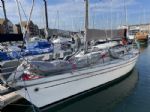












| Laser 28 - Excellent example of this great design Hamble le rice |
 |
| Laser 140101 Tynemouth |
 |
| Rossiter Pintail Mortagne sur Gironde, near Bordeaux |
 |
List classes of boat for sale |
Planing |
Post Reply 
|
Page <12 |
| Author | ||
JimC 
Really should get out more 

Joined: 17 May 04 Location: United Kingdom Online Status: Offline Posts: 6662 |
 Post Options Post Options
 Quote Quote  Reply Reply
 Topic: Planing Topic: PlaningPosted: 21 Apr 10 at 10:04am |
|
Its *much* more complicated than that!! Nothing special happens exactly at the point of the Froudes law calculation, but this is the beginner's topic. Edited by JimC |
||
 |
||
ColPrice2002 
Far too distracted from work 
Joined: 25 Nov 08 Location: United Kingdom Online Status: Offline Posts: 222 |
 Post Options Post Options
 Quote Quote  Reply Reply
 Posted: 21 Apr 10 at 9:40am Posted: 21 Apr 10 at 9:40am |
|
|
Hi, If you remember (?) - a "displacement" hull has to push the water aside as it sails. There is a formula - max speed = 1.3 times square root of the waterline length. Note speed in knots, length in feet and 1.3 is a factor that changes depending on the hull shape in question. So if you have a 16 ft boat (say a Wayfarer - for easy math!), max displacement speed is 1.3 x 4 = 5.2 knots. In a heavy yacht, there is no way that you can go faster (unless surfing) so you would adjust the sail area to sail at 5.2 knots. A saining dinghy, however, can "climb" out of the water and skin on the water. At this point, the hull isn't trying to push water aside, so the drag force reduces significantly, and the boat will plane. In a small dinghy, the transition can be dramatic (bow lifts out of the water, accelerates, "clean" wake). Just before planing, the dinghy will be making large bow & stern waves. Often there will be a high bow wave - with spray - not solid. The exact details will vary depending on the hull sections. HTH |
||
 |
||
ellistine 
Really should get out more 
Joined: 06 Mar 08 Online Status: Offline Posts: 762 |
 Post Options Post Options
 Quote Quote  Reply Reply
 Posted: 20 Apr 10 at 5:19pm Posted: 20 Apr 10 at 5:19pm |
|
That sounds logical. I'll have a look out for them. Thanks. |
||
 |
||
JimC 
Really should get out more 

Joined: 17 May 04 Location: United Kingdom Online Status: Offline Posts: 6662 |
 Post Options Post Options
 Quote Quote  Reply Reply
 Posted: 20 Apr 10 at 5:08pm Posted: 20 Apr 10 at 5:08pm |
|
OK, for that then, what you need is to know what the author of the article regarded as sub planing speed! For a lot of people the point is where the wake goes smooth and you get a wake line from the chines meeting somewhere aft of the transom. A powerboat racer, for instance, would regard planing as being a speed so high that there are only a tiny handful of dinghies capable of reaching it: in his terms most dinghies never get out of a semi-planing mode... |
||
 |
||
ellistine 
Really should get out more 
Joined: 06 Mar 08 Online Status: Offline Posts: 762 |
 Post Options Post Options
 Quote Quote  Reply Reply
 Posted: 20 Apr 10 at 4:14pm Posted: 20 Apr 10 at 4:14pm |
|
Just trying to get to grips with some sail trim issues (jib sheet tension mostly) and from what I've been reading there's a distinction between sub-planing and planing. Edited by ellistine |
||
 |
||
Matt Jackson 
Really should get out more 

Joined: 21 Sep 04 Location: Darlington Online Status: Offline Posts: 962 |
 Post Options Post Options
 Quote Quote  Reply Reply
 Posted: 20 Apr 10 at 4:11pm Posted: 20 Apr 10 at 4:11pm |
|
|
Thought I read an interesting definition in my Tasar manual years ago which was based on the position of the bow wave relative to the hull where (and this is where it gets a bit hazy) fully planing is when you overtake the bow wave. Sounds wrong when I re-read it. |
||
|
Laser 203001, Harrier (H+) 36
|
||
 |
||
JimC 
Really should get out more 

Joined: 17 May 04 Location: United Kingdom Online Status: Offline Posts: 6662 |
 Post Options Post Options
 Quote Quote  Reply Reply
 Posted: 20 Apr 10 at 3:31pm Posted: 20 Apr 10 at 3:31pm |
|
|
I think its one of those questions where the more you know about it the more difficult it is to come up with an answer! The older (maybe even wiser, but I doubt it) I get the less I think I understand the difference between planing and not planing. I don't think there's a hard and fast definition and I'm very sure there's not a single point at which a boat is or isn't planing. Its more a question of a range during which a boat is partially planing...
That doesn't help at all does it! Why do you want to know? |
||
 |
||
ellistine 
Really should get out more 
Joined: 06 Mar 08 Online Status: Offline Posts: 762 |
 Post Options Post Options
 Quote Quote  Reply Reply
 Posted: 20 Apr 10 at 1:08pm Posted: 20 Apr 10 at 1:08pm |
|
|
Daft question perhaps but how do you know when a boat is
planing? I initially thought it was when it started to hum but I now know that's more the result of a crap foil. Assuming 'quiet' foils what are the indications that boat has just start to plane? |
||
 |
||
Post Reply 
|
Page <12 |
| Forum Jump | Forum Permissions  You cannot post new topics in this forum You cannot reply to topics in this forum You cannot delete your posts in this forum You cannot edit your posts in this forum You cannot create polls in this forum You cannot vote in polls in this forum |
Copyright ©2001-2010 Web Wiz
Change your personal settings, or read our privacy policy












 Printable Version
Printable Version Delicious
Delicious Digg
Digg Facebook
Facebook Furl
Furl Google
Google MySpace
MySpace Newsvine
Newsvine reddit
reddit StumbleUpon
StumbleUpon Twitter
Twitter Windows Live
Windows Live Yahoo Bookmarks
Yahoo Bookmarks Topic Options
Topic Options